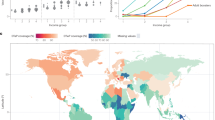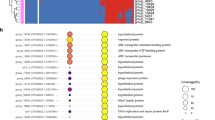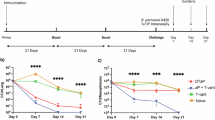Abstract
We replaced the wild-type TOX operon of Bordetella pertussis with in vitro mutated, detoxified alleles by electroporetic transformation using unmarked linear DNA. Uptake of DNA was selected by transient ampicillin resistance and two simultaneous recombination events resulted in gene-replacement at the natural locus with no integration of heterologous DNA. TOX alleles were stable without selection and recombinant strains secreted non-toxic, fully assembled, protective pertussis toxin (PT) analogues with kinetics similar to the parental vaccine strain under production-scale fermentation conditions. Strains generated in this way are suitable for the production of recombinant whole-cell or component whooping cough vaccines that require no chemical modification of PT.
This is a preview of subscription content, access via your institution
Access options
Subscribe to this journal
Receive 12 print issues and online access
$259.00 per year
only $21.58 per issue
Buy this article
- Purchase on SpringerLink
- Instant access to full article PDF
Prices may be subject to local taxes which are calculated during checkout
Similar content being viewed by others
References
Fine, P.E.M. and Clarkson, A. 1987. Reflections on the efficacy of pertussis vaccines. Rev. Infect. Dis 9: 866–883.
Ross, E.M. 1988. Reactions to whole-cell pertussis vaccine, p. 375–393. In: Pathogenesis and Immunity in Pertussis. A. C. Wardlaw and R. Parton (Eds.). John Wiley, Toronto.
Robinson, A. and Ashworth, L.A.E. 1988. Acellular and defined-component vaccines against pertussis, p. 399–417. In: Pathogenesis and Immunity in Pertussis. A. C. Wardlaw and R. Parton (Eds.). John Wiley, Toronto.
Pittman, M. 1984. The concept of pertussis as a toxin-mediated disease. Pediatr. Infect. Dis. 3: 467–486.
Tamura, M., Nogimori, K., Murai, S., Yajima, M., Ito, K., Katada, T., Ui, M. and Ishii, S. 1982. Subunit structure of islet-activating protein, pertussis toxin, in conformity with the A-B model. Biochemistry 21: 5516–5522.
Munoz, J.J., Arai, H. and Cole, R.L. 1981. Mouse-protecting and histamine sensitizing activities of pertussigen and fimbrial hemagglutinin from Bordetella pertussis. Infect. Immun. 32: 243–50.
Locht, C. and Keith, J.M. 1986. Pertussis toxin gene: nucleotide sequence and genetic organization. Science 232: 1258–1264.
Nicosia, A., Perugini, M., Franzini, C., Casaligi, C., Borri, M.G., Antoni, M., Almoni, M., Neri, P., Ratti, G. and Rappuoli, R. 1986. Cloning and sequencing of the pertussis toxin genes: operon structure and gene duplication. Proc. Natl. Acad. Sci. U.S.A. 83: 4631–4635.
Loosmore, S.M., Cunningham, J.D., Bradley, W.R., Yao, F.-L., Dekaban, G.A. and Klein, M.H. 1989. A unique sequence of the Bordetella pertussis toxin operon. Nucleic. Acids Res. 17: 8365.
Cockle, S.A. 1989. Identification of an active-site residue in subunit S1 of pertussis toxin by photocrosslinking to NAD. FEBS Letts. 249: 329–332.
Cieplak, W., Burnette, W.N., Mar, V.L., Kaljot, K.T., Morris, C.F., Chen, K.K., Sato, H. and Keith, J.M. 1988. Identification of a region of S1 that is required for enzymatic activity and that contributes to the formation of a neutralizing antigenic determinant. Proc. Natl. Acad. Sci. U.S.A. 85: 4667–4671.
Pizza, M., Bartoloni, A., Prugnola, A., Silvestri, S. and Rappuoli, R. 1988. Subunit S1 of pertussis toxin: mapping of the regions essential for the ADP-ribosyltransferase activity. Proc. Natl. Acad. Sci. U.S.A. 85: 7521–7525.
Barbieri, J.T. and Cortina, G. 1988. ADP-ribosyltransferase mutations in the catalytic subunit of pertussis toxin. Infect. Immun. 56: 1934–1941.
Zealey, G., Loosmore S., Cockle, S., Boux, H., Radika, K., Yacoob, R., Chong, P., Yao, F.-L. and Klein, M. 1989. p. 259–263. Construction of Bordetella pertussis strains that secrete inactive pertussis toxin analogs. In: Vaccines 89, Modern Approaches to New Vaccines Including the Prevention of AIDS. R. A. Lerner, H. Ginsberg, R. M. Chanock, and F. Brown (Eds.). Cold Spring Harbor, New York.
Pizza, M., Covacci, A., Bartoloni, A., Perugini, M., Nencioni, L., De Magistris, M.T., Villa, L., Nucci, D., Manetti, R., Bugnoli, M., Giovannoni, F., Olivieri, R., Barbieri, J.T., Sato, H. and Rappuoli, R. 1989. Mutants of pertussis toxin suitable for vaccine development. Science 246: 497–499.
Nencioni, L., Pizza, M., Bugnoli, M., De Magistris, T., Di Tommaso, A., Giovannoni, F., Manetti, R., Marsili, L., Matteucci, G., Nucci, D., Olivieri, R., Pileri, P., Presentini R., Villa, L., Kreeftenberg, J.G., Silvestri, S., Tagliabue, A. and Rappuoli, R. 1990. Characterization of genetically inactivated pertussis toxin mutants: candidates for a new vaccine against whooping cough. Infect. Immun. 58: 1308–1315.
Loosmore, S.M., Zealey, G.R., Boux, H.A., Cockle, S.A., Radika, K., Fahim, R.E.F., Zobrist, G.J., Yacoob, R.K., Chong, P.C.-S., Yao, F.-L. and Klein, M.H. 1990. Engineering of genetically-detoxified pertussis toxin analogues for the development of a recombinant whooping cough vaccine. Infect. Immun. In press.
Ditta, G., Schmidhauser, T., Yakobson, E., Lu, P., Liang, X.-W., Finlay, D., Guiney, D. and Helinski, D. 1985. Plasmids related to the broad host range vector pRK290, useful for monitoring gene expression. Plasmid 13: 149–153.
Dean, D. 1981. A plasmid vector for the direct selection of strains carrying recombinant plasmids. Gene 15: 99–102.
Stibitz, S., Black, W. and Falkow, S. 1986. The construction of a cloning vector designed for gene replacement in Bordetella pertussis. Gene 50: 133–140.
Park, C. and Hazelebauer, G.L. 1986. Transfer of chromosomal mutations to plasmids via Hfr-mediated conduction. J. Bacteriol. 165: 312–314.
Kiel, J.A.K.W., Vossen, J.P.M.J. and Venema, G. 1987. A general method for the construction of Escherichia coli mutants by homologous recombination and plasmid segregation. Mol. Gen. Genet. 207: 294–301.
Liljestrom, P., Pirhonen, M. and Palva, E.T. 1985. In vivo transfer of chromosomal mutations onto multicopy plasmids by transduction with bacteriophage P1. Gene 40: 241–246.
Jason, M. and Schimmel, P. 1984. Deletion of an essential gene in Escherichia coli by site-specific recombination with linear DNA fragments. J. Bacteriol. 159: 783–786.
Zealey, G., Dion, M., Loosmore, S., Yacoob, R. and Klein, M. 1988. High frequency transformation of Bordetella by electroporation. FEMS Microbiol. Lett. 56: 23–126.
Chassy, B.M., Mercenier, A. and Flickinger, J. 1988. Transformation of bacteria by electroporation. Trends in Biotech. 6: 303–309.
Imaizumi, A., Suzuki, Y., Ono, S., Sato, H. and Sato, Y. 1983. Effect of heptakis(2,6-O-dimethyl)β-cyclodextrin on the production of pertussis toxin by Bordetella pertussis. Infect. Immun. 41: 1138–1143.
Ish-Horowicz, D. and Burke, J.F. 1988. Rapid and efficient cosmid cloning. Nucleic Acids Res. 9: 2989–2998.
Yacoob, R.Y. and Zealey, G.R. 1988. A one-step procedure for the purification of high molecular weight bacterial chromosomal DNA. Nucleic Acids Res. 16: 1639.
Maniatis, T., Fritsch, E.F. and Sambrook, J. 1982. Molecular Cloning: A Laboratory Manual. Cold Spring Harbor Laboratory Press, Cold Spring Harbor, N.Y.
Tan, U.L., Fahim, E.F.F., Jackson, G., Phillips, K., Wah, P., Alkema, D., Zobrist, G., Herbert, A., Boux, L., Chong, P., Harjee, N., Klein, M. and Vose, J. 1990. A novel process for preparing an acellular pertussis vaccine composed of nonpyrogenic toxoids of pertussis toxin and filamentous hemagglutinin. Molec. Immunol. In press.
Burns, D.L., Kenimer, J.G. and Manclark, C.R. 1987. Role of the A subunit of pertussis toxin in alteration of Chinese Hamster Ovary cell morphology. Infect. Immun. 55: 24–28.
Watkins, P.A., Burns, D.L., Kanaho, Y., Liu, T.-Y., Hewlett, E.L. and Moss, J. 1985. ADP-ribosylation of transducin by pertussis toxin. J. Biol. Chem. 260: 13478–13482.
Author information
Authors and Affiliations
Rights and permissions
About this article
Cite this article
Zealey, G., Loosmore, S., Yacoob, R. et al. Gene Replacement in Bordetella pertussis by Transformation with Linear DNA. Nat Biotechnol 8, 1025–1029 (1990). https://doi.org/10.1038/nbt1190-1025
Received:
Accepted:
Issue date:
DOI: https://doi.org/10.1038/nbt1190-1025



